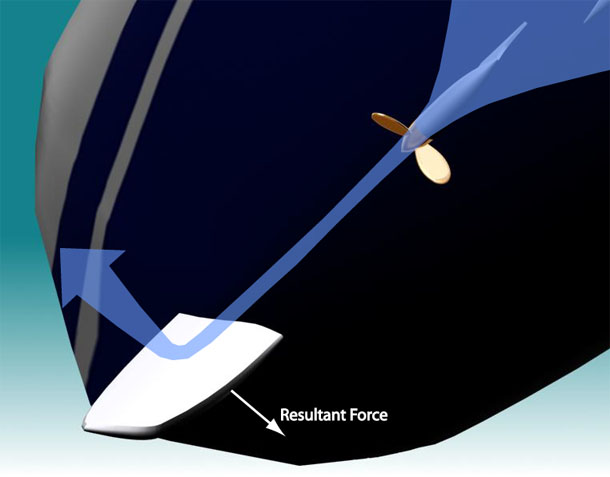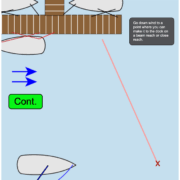Sign up with NauticEd for FREE (no obligation) and receive 2 free boating courses, a free eLogbook and boating resume, and more! If you want to get started in boating or are experienced and want to expand your knowledge and skills, consider taking our many online sailing and powerboating courses.
How to Dock a Catamaran on a T-Head Dock
Here’s how I like to teach docking a catamaran onto a T-head: slow is smooth, smooth is fast. The wind can be your helper depending on how you set up the approach. In this video we go, step-by-step, through five real-world scenarios—(1) wind ahead, (2) wind astern, (3) wind blowing you on, (4) wind blowing you off, and (5) a lateral “ferry” (crab) approach—so you can pick the right technique for the conditions in front of you.
You’ll see close-ups of the throttles and exactly when and why I use opposing engines, when to shift to neutral, and which line to make fast first so the boat stays where you put it. It’s practical boat-handling aimed at building true competence, not just “luck” docking methods.
Watch it, visualize it, then go practice it. That’s how you turn docking anxiety into muscle memory—and how you make every arrival look intentional.
Cheers! Grant Headifen
Watch the video…
Key Takeaways (Catamaran T-Head Docking)
- Best overall approach: For most conditions, a 45° approach with controlled speed works—use reverse on both engines to stop, then opposing engines (outside in reverse, dock-side forward) to align parallel.
- Wind ahead: You can either drive in at 45° or ferry-glide (crab) sideways by letting the wind counter forward motion. Make small throttle inputs; neutral lets the wind set you down gently.
- Wind astern (tailwind): Overshoot and reverse in. Slow early—tailwinds add momentum. Straighten the legs in reverse, then square up and secure lines.
- Wind blowing you on: Use the wind. Pause adjacent to the slot and let the boat slide sideways. Light, consistent throttle taps keep the bows aligned; line order is less critical because the wind pins you on.
- Wind blowing you off: Get a bow line on first (if safe) before the bow sails away. Then hold the stern with opposing engines while you secure the aft line and the rest.
- Throttle & rudder philosophy: Think in engine vectors, not wheel turns. Small, deliberate bursts on twin engines beat big helm swings in tight marinas.
- Line order that sticks: In most scenarios, bow line first, then stern stabilizes the boat fastest; adjust based on wind (upwind line first).
- Speed discipline: Slow is smooth, smooth is fast. Enter at idle + bursts; stop the boat before the dock, then place it where you want it.
- Situational setup: Aim to arrive nearly stopped, already angled for your intended rotation. If you blow the setup, bail out and reset—that’s good seamanship.
- Practice to competence: Visualize the sequence, then rehearse in light wind to build muscle memory for busy, gusty marinas.
Docking a Catamaran Video Transcript
Grant Headifen (Global Director of Education, NauticEd):
Hi, I’m Grant Headifen. Today I’m going to show you how to dock a catamaran onto a T-head in a range of wind conditions. In the video you’ll see close-ups of the throttles so you can track exactly how each maneuver is done.
1) Wind from Ahead: 45° Approach, Drive In, Then Align
We’ll approach the dock at about a 45° angle and drive in under control. As we arrive, I slow the boat with reverse on both engines, ease the bows gently to the dock, and then use reverse on the outside engine with forward on the dock-side engine to rotate the boat parallel. Once we’re parallel, shift to neutral, secure the forward (bow) line to stabilize the boat, and then add the aft line. Nice and tidy.
2) Wind from Ahead: “Ferry” (Crab) Across the Wind
This time, rather than driving straight in, we’ll ferry the boat sideways into the slot:
- Set the boat at an angle pointing toward the dock.
- Make slow forward way and let the wind counteract your upwind movement so the boat “crabs” sideways.
- If you drift too far upwind, go to neutral and let the wind push you down.
- Make small throttle and steering adjustments to maintain sideways motion.
- When you’re in the slot, use opposing engines to turn parallel and then secure lines—bow first, then stern.
- Go slow; patience makes this look effortless.
3) Wind from Astern (Behind): Overshoot, Then Back In
With wind pushing from behind, turning directly into the slot can blow you onto the boat ahead. Instead:
- Pass the slot slightly, then reverse in.
- Remember you’re being pushed, so slow down early.
- Use opposing engines to line up, then straighten the legs in reverse and ease back into the slot.
- Once in, square the boat with the engines and secure lines. Start with the aft (upwind) line first, then the others. Done.
4) Wind Blowing You On to the Dock: Let the Wind Help
Here we’ll let the breeze do the heavy lifting:
- Angle in, stop adjacent to your slot, and pause.
- Light, consistent throttle inputs keep the boat aligned as the wind slides you sideways to the dock.
- As you touch, square up parallel and attach lines—order isn’t critical because the wind is pinning you on. Easy.
5) Wind Blowing You Off the Dock: Secure a Bow Line Early
When the wind’s trying to peel you away:
- Approach at roughly 45°, slow with reverse on both engines, and get very close before committing.
- If safe, get a bow line on first to stop the bow blowing off.
- Then use reverse on the outside engine and forward on the dock-side engine to rotate the stern in.
- Hold that gentle opposing-throttle pressure to keep the stern against the dock while you secure the aft line and the rest.
- If you delay getting a line on, you’ll get blown off and have to reset—so prioritize that first line quickly.
###
You can learn more with NauticEd

Sign up with NauticEd for FREE (no obligation) and receive 2 free boating courses, a free eLogbook and boating resume, and more! If you want to get started in boating or are experienced and want to expand your knowledge and skills, consider taking our many online sailing and powerboating courses.









